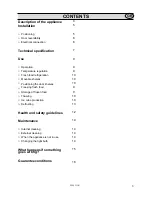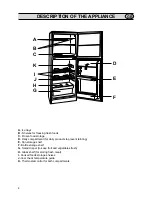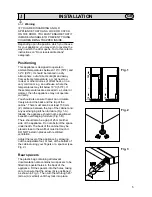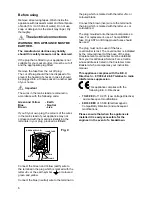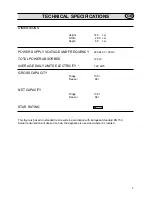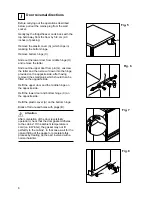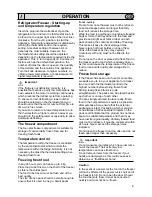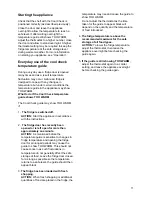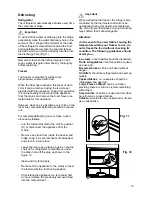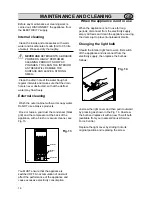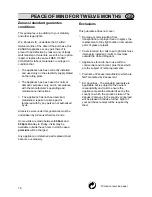
D040
D113
Fig. 9
Fig. 10
10
Thawing
Food can be thawed in a number of ways,
depending on the type of food and the size of the
packs. Meat, fish and fruit should be thawed in
the refrigeration compartment and small pieces of
meat or poultry can even be cooked while still
frozen, but you must ensure that it is thoroughly
cooked through. Vegetables should be directly
immersed in boiling water; ready-cooked dishes
can be placed directly in the oven in their
aluminium wrapping. A microwave oven is
particularly suitable for thawing any type of frozen
or deep-frozen food: follow the oven instructions,
particularly regarding the placement of aluminium
wrapping in the oven.
Ice making
Fill the ice trays with water to the top of each ice
cube compartment, and place them in the freezer
compartment. To release the ice cubes, twist the
tray along its length.
Never use a sharp instrument to remove the ice
trays.
Fresh food refrigeration
To obtain the best performance, do not store
warm food or evaporating liquide in the
refrigeratori do cover or wrap the food,
particularly if it has a strong flavour. Do not cover
the shelves with any protective material, such as
paper, cardboard or plastic, which may obstruct
the air circulation through them.
To help you use your refrigerator correctly, here
are some more useful hints:
Raw meat (beef, pork, lamb & wild fowl): wrap in
polythene bags and place on top of the salad
crisper.
Meat can only be stored safely in this way for
one or two days at the most.
Fruit & vegetables: these should be thoroughly
cleaned and placed in the bottom salad crispers.
Butter & cheese: these should be placed in
special airtight containers or wrapped in
aluminium foil or polythene bags to exclude as
much air as possible.
Milk bottles: these should have a cap and should
be stored in the bottle rack on the door.
The walls of the refrigerator are equipped with
runners so that shelves can be positioned as
desired (Fig. 9)
Cool check temperature guide
This model has a cool check temperature guide
fitted to a shelf in the fridge compartment. The
guide is designed to show whether the fridge is
operating at safe temperatures for all food
types. The guide consists of a temperature
sensitive strip sealed in the shelf trim.
When the fridge is operating at the safe
temperature to store food, the guide will appear
black. If the temperature in the fridges rises the
guide will show the words TOO WARM. The
temperature in the fridge may rise if the door
has just been opened, the fridge has just been
loaded with shopping or if the room temperature
is higher than normal. See “Everyday use of the
temperature guide” for further information.
The shelf with Cool Check temperature guide
must be placed in the fridge according to the
instructions located on the fridge wall and
always ensure the guide ís at the front.
When clearing the shelf take care not to
immerse the guide in water and wipe any spills
from the holder quickly.
Important
The guide is only suitable for use in the model
supplied and accurate temperature guidance
cannot be guaranteed if transferred to other
appliances.
The guide will not work in the freezer
compartment.
Positioning the door shelves
To permit storage of food packages of various
sizes, the door shelves can be adjusted in
height. To do this proceed as per Fig. 10.



